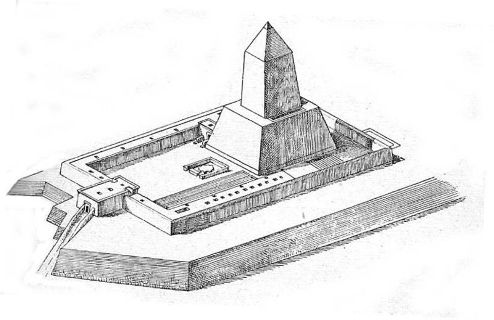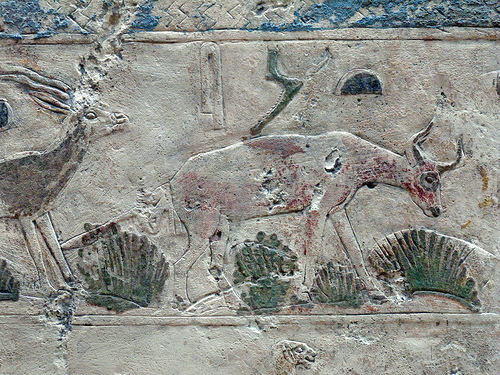

Location: Map

Abu Gurab is the modern name of an important archaeological site
in Egypt, located about one kilometer north of Abusir.
Located on the western bank of the Nile between Giza and Saqqara, it
preserves the remains of six solar temples of the 5th dynasty, cited
by written sources such as the numerous papyri found at Abu Sir and
more specifically the Userkhau Papyri, but of which only two have
been identified and brought to light: that of Userkaf and the better
known one of Setibtawy more commonly called by the name of Niuserra.
The site was discovered at the beginning of the 19th century
when the appearance of finds referring to the Old Kingdom attracted
the attention of archaeologists to Abu Gurab, where the Napoleonic
expedition and Lepsius had already reported the presence of ruins.
During the V Dynasty there was a notable influence of
Heliopolitan theology which pushed the rulers to build solar temples
proclaiming themselves "Sons of Ra" for the first time and declaring
their divine descent.

The solar temple of Niuserra was discovered by the Englishman
Perring in 1837 but was already known by the name of "Pyramid of
Reegah".
In 1898, the German mission of Friedrich von Bissing
and Ludwig Borchardt began systematic excavations of the site, which
immediately proved difficult since it was one of the most evocative
and unusual architectural complexes of ancient Egypt which is
supposed to be a replica of the temple of Ra ad Heliopolis, now
disappeared.
It was built on commission by Setibtawy
(Greekized name Rathoris), sixth ruler of the 5th dynasty. The exact
dating of his reign is unknown to us, but it is hypothesized that he
ascended the throne sometime between 2450 B.C. and 2430 BC.
This ruler is also known for having built a pyramid and a burial
chamber in the archaeological complex of Abu Sir, while the complex
of Abu Gurab, which had the name of "He who gladdens the heart of
Ra" was probably built in a more recent phase. late in his reign,
perhaps around 2420 BC. on the occasion of the Heb-Sed festival.
The temple was made up of numerous structures but the true
sanctuary of the sun was the large courtyard measuring 80 meters by
110 metres, located in the upper part of the temple which was
accessed via a covered ramp 90 meters long and with a 16 meter
difference in height and where the star was venerated in the open
air, probably at sunset.
The courtyard was dominated by a
squat obelisk made of bricks called Benben, visible from the whole
valley and ancestor of the monolithic ones of the New Kingdom, about
36 meters high on a base of about 20 metres, both covered in white
limestone and with the pyramidion in granite covered with golden
copper sheets that reflected the sun's rays with blinding flashes.
In the center of the courtyard there is, still today, a notable
monumental alabaster altar where ceremonies of sacrifice and
offerings were celebrated in direct contact with the god present as
sunlight.
The altar of sacrifices is made up of four
alabaster blocks arranged around a circular element of about six
meters and has an unusual shape.
Grooves on the floor
collected the blood of the sacrificed animals in nine containers
also made of alabaster.
In the complex, there was also a
slaughterhouse and a series of warehouses. The corridor surrounding
the courtyard ended in a room called the "Chamber of the Seasons"
where some reliefs represented the flora and fauna during the three
seasons with scenes of work in the fields. There were also splendid
reliefs on Hapy, on the divinities of the nomoi and of the latter
the list appears to be the oldest found. The scenes of the Heb-Sed
festival and the founding of the temple are also of great interest.
All these representations had in common the sun with its
beneficial powers, they were illuminated by the rising star and to
save them from degradation they were transferred to the Egyptian
Museum in Cairo and to the Ägyptisches Museum und Papyrussammlung in
Berlin.
Outside the temple, beyond the surrounding wall there
is the simulacrum of the solar boat, 30 meters long, built of bricks
that still have traces of painted plaster and placed inside a cavity
dug into the rock.
With its bow towards the west, it was one
of the two boats, called Maaty, which the god Ra used and it was
perhaps the nocturnal one, called Seketet, used on the journey
towards rebirth.
But it could also have been the daytime one,
called Mandjet with which the rising Ra crossed the sky from east to
west, a sky that the Egyptians imagined as a large expanse of water.
From the temple came a lion's head, made of red granite, now
preserved in the Cairo Museum which was a representation of Ra and
symbolized the power of the sovereign.
The solar temple of Userkaf, first ruler of the 5th dynasty, is by
far the oldest temple found; among its ruins a head of Userkaf in
greywacke was found, among the masterpieces of art of the time.
Built of mud bricks, it was brought to light in 1954 by the
Swiss archaeologist Ricke, a pupil of the architect Borchardt, but
even if reduced to a few remains, these were enough to understand
that it was similar to the neighboring one of Niuserra.